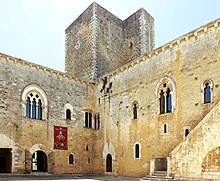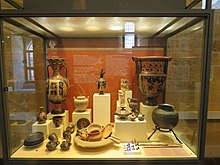Gioia del Colle
| Gioia del Colle | ||
|---|---|---|

|
|
|
| Country | Italy | |
| region | Apulia | |
| Metropolitan city | Bari (BA) | |
| Coordinates | 40 ° 48 ′ N , 16 ° 56 ′ E | |
| height | 365 m slm | |
| surface | 206 km² | |
| Residents | 27,418 (Dec. 31, 2019) | |
| Population density | 133 inhabitants / km² | |
| Post Code | 70023 | |
| prefix | 080 | |
| ISTAT number | 072021 | |
| Popular name | gioiesi | |
| Patron saint | San Filippo Neri | |
| Website | Gioia del Colle | |
 Gioia del Colle, Municipio (Town Hall) |
||
Gioia del Colle is an Italian municipality with 27,418 inhabitants (as of December 31, 2019) in the metropolitan city of Bari in Apulia .
geography
The city lies on a hill (365 m), which separates the Murge of the northwest from those of the southeast. The plateau is halfway between the Ionian and Adriatic Seas with almost the same distance between the Lucanian center of Matera and the Apulian cities of Bari and Taranto .
history
Prehistoric times
The history of Gioia del Colle goes back to the 9th century BC. BC when the first settlements were established in the nearby town of Monte Sannace , the main center of the Peuketeers .
Roman times
In Roman times the city was destroyed, the place was abandoned for several centuries until it was expanded to include a fortress of Byzantine origin and then, in Norman times, it was turned into a castle that forms the first nucleus of the current city of Gioia del Colle. Today's archaeological park includes some sections of the defensive ring and the north gate.
During the Byzantine Empire, the first urban settlement arose on what is now the city (Borgo S. Nicola), where you can admire some of the most impressive architectural structures of the time: the arches of Constantinopoli, Nardulli, Mastrocinto, S. Nicola, Cimone; the tower house; the church of S. Andrea; the mother church and also smaller architectural and sculptural forms such as the pillars, the decorated oculus (= eye) and the decorative door knockers .
Middle Ages and Modern Times
The archaeological area of Monte Sannace, one of the most important centers of peucetians, and Norman-Hohenstaufen Castle, with the people of Frederick II. From the noble family of the Staufer and Bianca Lancia , the Manfred of Sicily is linked gave birth to testify the archaeological and historical-architectural importance of the city.
Gioia then came under numerous dominions such as B. the Hohenstaufen , Angevinen and Aragonese and then went on in the Kingdom of Naples until 1860. After that it became a city of the Kingdom of Italy .
Second World War
After Italy entered the war in June 1940, the fascist regime set up an internment camp ( campo di concentramento ) in Gioia del Colle . It was in a disused dough factory along an arterial road away from the village center. The camp housed a total of 59 internees, all of them Italian Jews with the exception of two foreigners . High walls surrounded the area and gave the building the appearance of a barracks . There were two dormitories, each with 50 beds, a sickroom and running water; However, the sanitary facilities were primitive, the rooms could not be heated and there was no connection to the power grid. The Ministry of the Interior soon ordered the camp to be closed. The last internees were deported to other camps in June 1941.
economy
From an economic point of view, Gioia del Colle is one of the most productive rural areas in the province and has a particularly significant production in the agricultural and winemaking sectors, with Primitivo wine in the foreground (see Gioia del Colle wine ).
Milk production is particularly developed: Gioia del Colle's mozzarellas and dairy products have established themselves in markets throughout Italy and beyond due to their high quality. No less important is the production of extra virgin olive oil.
Attractions
Norman-Hohenstaufen castle
The castle of Gioia del Colle is the most notable monument in the city and one of the most beautiful castles in the Puglia region . It was built in Byzantine times, at the time of the Norman Count Riccardo Siniscalco d'Altavilla from the noble family of Hauteville (12th century). Destroyed by Wilhelm of Sicily, it was rebuilt in 1230 by Emperor Friedrich II (the Staufer) after his return from the Crusades. The building received its current shape after the restoration work by Pantaleo (1907–1909) and De Vita (1969–1974).
From the outside, the visitor notices the imposing walls made of ashlar as well as the two towers that were originally four still standing (the Norman donjon “De Rossi” with a height of 28.40 meters and the “Tower of the Empress” (24.10 m) its wonderful oculus and lancet windows), furthermore the entrances from the south and west, which are characterized by radial arches and loopholes, the partitions that are criss-crossed by an extraordinary variety of ingenious openings.
Chiesa Madre - Santa Maria Maggiore
The mother church was built by Riccardo Siniscalco outside the city walls at the end of the 11th century and consecrated to Saint Peter . The services were held in Latin, in contrast to the Greek liturgy of the Church of St. Sophia (today St. Andrew).
In 1857 the building was badly damaged by a violent earthquake. The reconstruction was completed in 1893 at the expense of fellow citizen Pasquale Montaganaro. But in 1942 the 18th century bell tower also collapsed; later rebuilt in reinforced concrete, it was equipped with electrically operated bells. During this last work to stabilize the foundations, it was found that almost the entire underground was previously used as a burial site. The crypt probably dates back to when the Norman cathedral was built. Fearing that the perimeter of the foundations break and could affect the stability of the whole Church, the crypt was closed after the remains buried there in the ossuary (Ossario) of the cemetery had been taken.
In the Chiesa Madre you can admire the “Madonna and Child” by Stefano da Putignano , located in the aedicule to the right of the entrance (another Virgin and Child by the same sculptor is in Via Catapano 15).
Parco Archeologico di Monte Sannace
The complex is visible from afar, in an open area, 5 km from Gioia del Colle, in the direction of Putignano-Egnatia, along the path known as "Cavallerizza" that crosses the entire archaeological area. The residential area is not identified, it can probably be regarded as the city of “Thuriae”, called “Messapia” in the sources. The entire residential area is surrounded by concentric walls that are almost still visible. The first surrounds the Acropolis and dates back to the second half of the 4th century BC. BC back. The second, of the same age, has a gate and contains quarters along the valley; it also reveals Greek building techniques. The third and fourth walls date from the beginning of the 3rd century BC. Back to the 4th century BC: The third fortified the Acropolis, the fourth enclosing the entire residential area and surrounding an area that is much larger than the real dimensions of the city of that time: within the walls, non-urbanized areas were used in the event of war and in the event of long sieges Leave the population with their animals from the area.
traffic
Streets
The main roads nearby are:
- motorway car A14 (Adriatic highway) , of Bologna until after Taranto leads
- the state road SS100 - Strada statale 100 di Gioia del Colle.
railroad
At the station, the Rocchetta Sant'Antonio – Gioia del Colle line meets the Bari – Taranto line .
Military airfield
An important military airfield of the Italian Air Force has been located near Gioia del Colle since 1915 , where a squadron of Eurofighter Typhoon fighter jets has been stationed there. During the Cold War, the were at the base as part of nuclear sharing and nuclear bombs stored. The Royal Air Force used the base on various missions in the Balkans in the 1990s and in 2011 over Libya .
Personalities
- Bianca Lancia (around 1200/1210 – around 1244/1246), long-time lover and last wife of Emperor Frederick II , possibly died in Gioia del Colle (around 1244–1246)
- Frank Stallone (Staglione) Senior (1919 - 11 July 2011) - father of Sylvester Stallone
- Giovanni Intini (* 1965), Roman Catholic clergyman, Bishop of Tricarico
- Nicola Legrottaglie (* 1976), football player
Town twinning
Web links
Individual evidence
- ↑ Statistiche demografiche ISTAT. Monthly population statistics of the Istituto Nazionale di Statistica , as of December 31 of 2019.
- ↑ a b c Simona Caricato: La Storia della Città , (Facoltà di Lingue e Letterature Straniere c / o Università degli Studi di Bari), on comune.gioiadelcolle.ba.it, accessed on November 5, 2019
- ↑ Carlo Spartaco Capogreco, I Campi del duce. L'internamento civile nell'Italia fascista (1940-1943) , Torino 2004 (Einaudi), pp. 237-238
- ↑ Simona Caricato: Prodotti locali , on comune.gioiadelcolle.ba.it
- ↑ a b c Cosa Vedere - Places of interest ( en ) Comune di Gioia del Colle. Retrieved January 5, 2020.
- ^ Town twinning





